Painting Rooms to Change
Their Size and Shape
What if just by painting rooms, you could visually manipulate their shape and dimension?
It turns out, you can, so let's play illusionists today: you pick a room you'd like to change (a problem to correct), and I'll show you how easy it is to fool the eye by using a magic tool also known as... color!
Painting Small Rooms
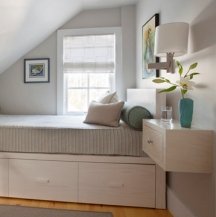
- Avoid high contrasts between the wall color and the ceiling, woodwork, furniture and decorations.
- Use light colors (pastels and the upper range of mid-tones) for painting and decorating.
- Choose cool and neutral tones (e.g. blues, greens, grays, taupes, etc) because they recede (seem more distant) rather than warm ones (yellow, orange, red).
- Avoid contrasting wall patterns, borders, moldings or anything else that draws too much attention to the walls.
- Add height to rooms with low ceilings with these ceiling painting tips and tricks.
Painting X-Large Rooms
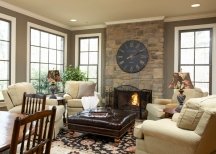
- Create a contrasting palette in your decor and paint colors.
- Install a chair rail or picture moldings, and paint the sections with a different color to create visual breaks in a large space.
- Take advantage of deeper/darker shades because they absorb more light and create a cozier atmosphere than light colors.
- Use warm colors for painting the walls (e.g. colors in the red, yellow and orange family) because they tend to advance and make the walls appear closer.
- Bring the walls closer by drawing attention to them and filling the blank expanse with decorative painting techniques, textures or wallpaper.
- Lower the ceiling by painting it a dark color, or enclose the space by painting both the ceiling and walls the same deep shade.
Painting Long Rooms
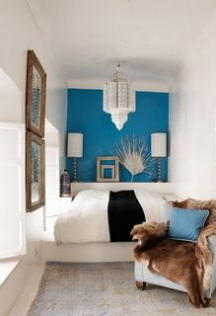
- Paint the 2 short walls in the room using a shade than the main wall color (about 2 shades darker than the long walls) - this will make the short walls visually "squash" the length of the room, so that its shape will seem more balanced.
- Use higher contrasting wall decor on the short walls, and more blending accents on the long ones to strategically direct the eye away from the wall length.
- Turn the short end wall into an accent wall, to draw attention to it and "pull" it closer (this works best in rooms that have only 1 solid short wall with no doors or windows - that way there is no confusion about why the wall is featured).
Painting Short Corridors
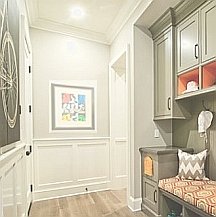
- Paint the end wall in the corridor with a lighter shade than the side walls, to create an illusion of a little bit more space ahead (it's important because a dark color on that wall will create a "dead end" effect instead).
- Make sure the color scheme is blended, with no high contrasts (especially on the facing/end wall) that can make the small space look even more closed in.
- Elongate the corridor and push the end wall out by painting horizontal stripes on the side walls.
Painting Narrow Hallways
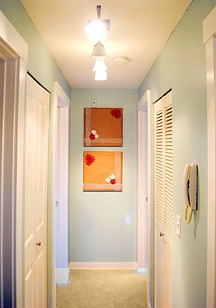
- Go with light, pale colors for the walls in a long, narrow hallway to avoid closing in the space even more and creating a claustrophobic effect that dark colors can do.
- Use the same tips and tricks as for painting long rooms (see above) because the same solutions (creating a focal wall, using contrasting wall decor) apply here as well.
- Paint the ceiling a deeper shade than the walls (only if the ceiling is high) - this will "squash" the hallway vertically and help make the space look a bit more square-shaped and not as stretched out.
Painting Boxy Rooms
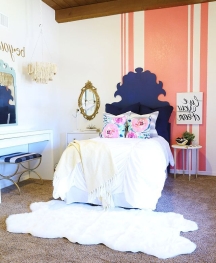
- Create an asymmetrical focal wall to add some interest to the boring room shape (use these wall painting ideas for inspiration).
- Change the proportions of the room by using a deeper shade on the walls that you want to bring forward (it can be 2 adjoining or 2 opposite walls).
- Paint contrasting vertical stripes on 1 or 2 walls to create an illusion of structure and make the room seem less square (a very effective way is to start the stripes at the last third of one wall, and stop them at the last third of the next wall).
Painting Featureless Rooms
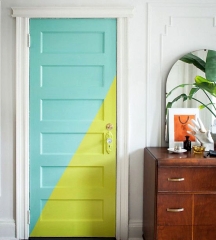
- Choose bright, high contrasting or just not conventional colors on the wall(s), ceiling, trimwork or any other element that you want to highlight and turn into an accent.
- Color block the walls by painting the top and bottom with 2 different colors, and leaving a strip of white (or another color) between them (you can also do it vertically, diagonally and asymmetrically).
- Add interest to any surface via decorative painting techniques and faux finishes (which can be done on the walls, ceilings, floors and even doors).
Concealing Architectural Eyesores
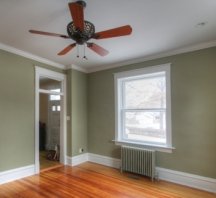
- Paint over the vents, pipes, wires, electric plates and radiators using the wall color and finish.
- Avoid using contrasts, decorative finishes or attention-grabbing color combinations anywhere and on all surfaces that you want to downplay (monochrome is your best friend).
- Camouflage oddly shaped ceilings or numerous crannies and corners by using the same color and finish throughout the room, then direct the eye away from the problems with contrasting furniture and interesting accents placed in the middle of the room.
So, there you have it - try these simple ideas and you'll be amazed at how many design problems can be easily solved, just by painting rooms with a bit of creativity and strategy!
See Also:
Painting Ceilings to Change Their Height
Ideas and Instructions for Painting Stripes
Wall Painting Techniques for Imperfect Walls









Leave a Comment: